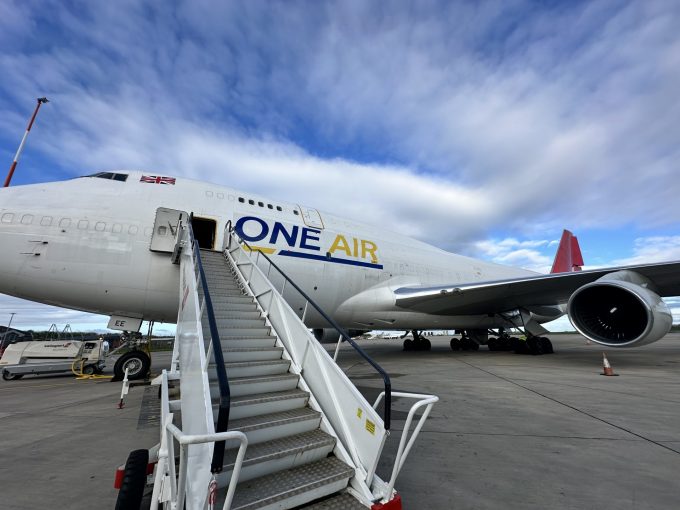News in Brief Podcast | Week 48 | Port ‘musical chairs’, rates and MSC u-turn
In this episode of The Loadstar’s News in Brief Podcast, host and news reporter Charlotte ...
FDX: ABOUT USPS PRIVATISATIONFDX: CCO VIEWFDX: LOWER GUIDANCE FDX: DISRUPTING AIR FREIGHTFDX: FOCUS ON KEY VERTICALFDX: LTL OUTLOOKGXO: NEW LOW LINE: NEW LOW FDX: INDUSTRIAL WOESFDX: HEALTH CHECKFDX: TRADING UPDATEWMT: GREEN WOESFDX: FREIGHT BREAK-UPFDX: WAITING FOR THE SPINHON: BREAK-UP ALLUREDSV: BREACHING SUPPORTVW: BOLT-ON DEALAMZN: TOP PICK
FDX: ABOUT USPS PRIVATISATIONFDX: CCO VIEWFDX: LOWER GUIDANCE FDX: DISRUPTING AIR FREIGHTFDX: FOCUS ON KEY VERTICALFDX: LTL OUTLOOKGXO: NEW LOW LINE: NEW LOW FDX: INDUSTRIAL WOESFDX: HEALTH CHECKFDX: TRADING UPDATEWMT: GREEN WOESFDX: FREIGHT BREAK-UPFDX: WAITING FOR THE SPINHON: BREAK-UP ALLUREDSV: BREACHING SUPPORTVW: BOLT-ON DEALAMZN: TOP PICK

One Air is planning a mix of B747 and B777 freighters to meet demand for ad hoc global charters and growing opportunities on the UK/Europe and China tradelane.
The UK cargo airline started operations in July last year with a B747-400F operating services between Asia and Europe, as well as charters, initially based at Heathrow but later moved operations to East Midlands Airport.
A second B747-400F, previously operated by several other carriers, including Air China and Aerotranscargo, which has the same shareholder as One Air, was added in December on a long-term lease. One Air employs around 150 people and is the only B747F operator on the UK register.
“We saw a need for a new British cargo carrier,” said Chris Hope, its chief operating officer. “We believe the full charter market provides us with the best growth opportunity through the start-up and development stages of our operation.”
And, given the size of the fleet, Mr Hope thinks it is the right business model to build on. One Air’s B747s have a 105-tonne payload and the plan is to add a third aircraft by early July.
“We are open to potentially more B747 freighters to enter the fleet, but also to add our first B777F this year,” he told The Loadstar.
Since the launch, he said, demand for capacity ex-China and Hong Kong has been consistently high.
“One Air expects the strong demand from China to Europe and the UK to remain and, and as the fleet grows, it will support more global charter bookings.”
The latest data from the UK Department of Business and Trade indicates trade in goods and services between the UK and China last year was £90.2bn ($115bn) – however, that is 20% down on 2022.
It seems the critical e-commerce market is providing significant opportunities for air cargo, illustrated by the booming Chinese business at gateways like at Bournemouth Airport (BOH) as an alternative entry point to the UK.
BOH anticipates continued strong growth in the e-commerce sector this year, “with perhaps a more pronounced peak in Q4 driven by an increased market penetration of the “e-tailers”, said the airport.
The summer will also see more belly capacity from China to the UK. On Saturday, Air China started daily A330-300s between Beijing and London Gatwick and, on 20 June, China Southern will launch Guangzhou to Gatwick services three times a week using B787s.
The average air cargo spot rate from China to Europe in April hit $3.94 per kg, according to data from Xeneta, 76% above its 2019 pre-pandemic level.
Niall van de Wouw, Xeneta’s chief airfreight officer, said the growth in spot rates on various tradelanes was largely driven by regional developments, as well as market sentiment tending to follow market fundamentals.
“The freight rate in April was a reaction to high first-quarter volumes, but we expect rates to ease,” he added.
Mr Hope has observed a significant increase in demand over the last few months, but believes this is not translating into a significant increase in rates. Rather it shows customers’ desire to enter longer-term commitments to secure capacity, which is extremely positive, he reckons.
According to IATA, air cargo markets were showing strong annual growth in demand into Q2, and the Asia-Europe lane in particular, grew by 17.7% in April.
Mr Hope said: “Market volumes since the turn of the year have been better than many expected. In terms of our current fleet, we have more than sufficient demand for our available capacity, so the outlook is positive – especially as we add more aircraft in the second half of the year.”
Comment on this article